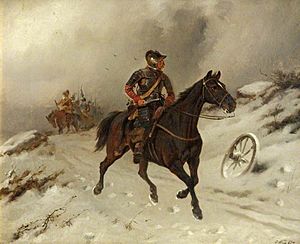Ironside (cavalry) facts for kids
The Ironsides were a special group of cavalry soldiers during the English Civil War in the 1600s. They were part of the Parliamentarian army, which fought against King Charles I. These soldiers were led by Oliver Cromwell, a powerful English leader.
Cromwell himself was sometimes called "Old Ironsides." This nickname was even given to him by Prince Rupert of the Rhine, a leader of the King's army, after a big battle. Soon, all of Cromwell's cavalry soldiers became known as the Ironsides.
Contents
Building a Strong Army
Cromwell first gathered a group of cavalry, also called "horse," on August 29, 1642. This was early in the Civil War. His group was not ready in time for the first major battle, the Battle of Edgehill.
After seeing his side's cavalry lose at Edgehill, Cromwell realized something important. He felt that the King's soldiers, who were often from noble families, fought with more spirit. He thought his own soldiers, who were often ordinary working men, needed something more.
Faith and Fighting Spirit
Cromwell believed that strong religious faith would make his soldiers better fighters. In 1643, he became a colonel and made his small group much bigger. This new regiment joined the Army of the Eastern Association.
Cromwell became known for choosing officers who were not necessarily rich or noble. Instead, he picked men who were very religious and had strong Puritan beliefs. These officers then attracted other soldiers who shared similar ideas.
Cromwell once wrote that he would rather have a "plain russet-coated captain" who knew what he was fighting for. He meant he preferred a simple, dedicated soldier over someone who was just a gentleman without real courage.
Early Victories
On July 28, 1643, Cromwell's regiment fought in the Battle of Gainsborough. They defeated the King's cavalry there. One of Cromwell's captains, James Berry, was even said to have killed the Royalist commander, Sir Charles Cavendish.
By April 1644, Cromwell's unit had grown very large. It was a "double" regiment, with 14 groups of soldiers, which was much more than a normal regiment. Cromwell was now a high-ranking general for the cavalry in the Eastern Association army. His cousin, Edward Whalley, often led the regiment in battle.
The regiment played a huge part in the Parliamentarian victory at the Battle of Marston Moor. Cromwell's cavalry showed great discipline. While some of the King's victorious cavalry scattered to find treasure, Cromwell's men stayed together. After beating their opponents, they helped clear the battlefield of the King's scattered forces. Sadly, Cromwell's nephew, Captain Valentine Walton, died from his wounds after this battle.
Later that year, at the Second Battle of Newbury, things were different. Cromwell's regiment was part of an attack on the King's forces. However, they were pushed back and needed help from other Parliamentarian cavalry.
The New Model Army's Core
Cromwell's large regiment was later split into two separate regiments. These two groups became the main part of the cavalry for the New Model Army. This was a new, professional army created by Parliament.
Just before the Battle of Naseby, Cromwell was again put in charge of the cavalry for the entire army. Eventually, he became the army's overall commander. The name "Ironsides" then started to be used for all the cavalry in the New Model Army, no matter where they came from.
At the Battle of Langport, two groups of Ironsides cavalry showed amazing bravery. They charged up a narrow lane and attacked the King's army head-on. This bold move helped make the entire Royalist army run away.
How the Ironsides Looked and Fought
Even though "Ironside" sounds like they wore heavy armor, Cromwell's soldiers were equipped like most cavalry of their time. They wore a back and chest plate for protection and a "pot" helmet. They seemed to have a more uniform look compared to the King's cavalry, who often had mixed equipment.
As Puritans, the Ironsides believed God helped them win battles. Their strong religious beliefs guided their actions. When they were not fighting, they followed strict rules. They did not drink or gamble. They also did not take things from defeated enemies or steal from towns.
Ironsides in Stories and Songs
The Ironsides appear in the 1953 historical novel Simon by Rosemary Sutcliff. In the book, they are shown as very professional soldiers with strong religious beliefs.
In music, the lyric "heaven is like Ironside's" in Bob Dylan's song "I Pity the Poor Immigrant" is said to refer to the strict religious views of Cromwell's followers.
See also
- Cromwell's Soldiers' Pocket Bible


